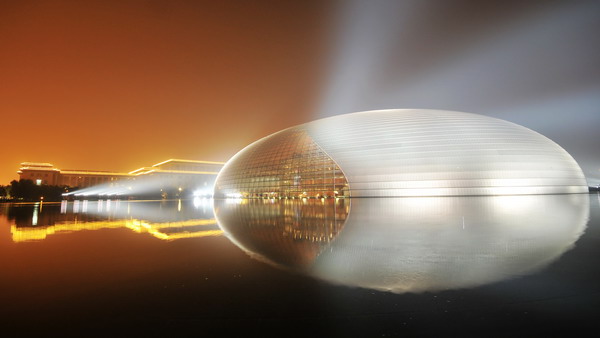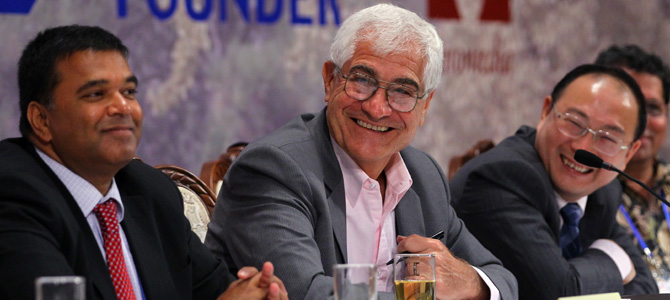
|
 |
|
Illuminations at the National Centre for the Performing Arts in Beijing during the celebrations to mark the 60th anniversary of the founding of the People's Republic of China. [Photo/China Daily] |
Zambello's experience on the production was rewarding but exhausting: "Bringing European culture to the Chinese requires a big learning curve. It was very difficult. They're not used to dealing with foreigners. Often the administration would say 'Yes, Yes, Yes' but then nothing would happen. They didn't want to say 'No'. It's the same in Japan.
"But I will say that working with the Chinese, I saw that they are very willing and they work hard. In so many places in the world, they will say 'This is just how we do things', but in China they really want to learn."
During the production, the Chinese performers were still learning to sing in the Western style, she said. Carmen, first staged in 1875, requires a sultry vibe, and it took a while for the Chinese performers to feel comfortable enough to touch each other on stage, she said.
"But in the end, I had to tell them to get their hands off each other," Zambello said with a laugh. "Ultimately I really loved the experience, and it was very moving for me."
Venues are a major factor in how the performing arts develop, Newhouse said. "In the West the emphasis is on natural acoustics, so that is the focus of the architect. But in China the natural acoustics are not as important. I think the Chinese are used to amplification. The theory is that this custom of amplifying almost everything originated during the 'cultural revolution' (1966-76) when slogans were constantly being broadcast, and that a taste for amplification developed during that time."
Carl Rosenberg, an acoustics expert for the consultancy Acentech Inc, who traveled to China with Newhouse, said the trend is to build all-in-one complexes that can accommodate theater, symphony orchestras and opera. In the West, these are usually performed in separate halls built specifically for the required acoustics and staging of each form, he said.
"The grand theaters in China try to do it all, and a space which will be used for Chinese opera one night will be used for a grand symphony the next," he said. "That's a very challenging acoustic requirement. I don't want to be presumptuous in saying that the value or quality is not good, and I would say that more often than not for the programs they are presenting it's quite successful. Most of their productions are amplified, and overall the sound quality is good."
Frustrations
Often, the architects commissioned to build these centers aren't from a musical background, Zambello said. "They've hired amazing architects for whom I have great respect, but they don't work in what we do, so they don't have a connection," she commented. "There are many impractical things about the way the buildings are set up. That's very frustrating, but anyone who works in theater will tell you that in the US too."
On the upside, there is room for experimentation that might not always be possible elsewhere, Newhouse said. She pointed to Iraqi-British architect Zaha Hadid's Guangzhou Opera House, which employed a revolutionary asymmetrical design featuring breakthrough acoustics technology. However, Hadid was the "winner" of the region's fourth competition to design the center, making it clear that the competition was ultimately only a pretext for local government to select its own designer, she said.
Other complications have emerged because of timing, Smith said. "Sometimes performing arts venues will be completed and then lie dormant for a year," he said. "They'll decide on the Vienna Philharmonic, and then say, 'Can we get them in three months?' They have a sense of reality that on the one hand is very connected to how the rest of the world looks, but is very remedial in terms of how the rest of the world actually functions."
"It's not an organic growth; they are building the halls at the same time as they are building the audiences for the halls. In America, they built halls because the audience had outgrown a previous hall, and orchestras developed a sound based on their own halls. But the audience and the halls don't actually exist yet in China."
In the United States, the arts, and public and private investment in them, first developed in major metropolitan cities before moving to medium-sized regional centers. In China, the initial wave hasn't even died down but the second wave is picking up, Smith said.
Other people have seen project plans fall apart as supporters have fallen out of favor politically, he said. But as funding models for the arts in Europe and the US have struggled over the past decade, China might ultimately provide a path for the future, he said.
"China is being expected to do something that we (the West) don't even seem to have a successful model for yet," he said. "So they have to find popular support for international art forms that have never really had a broad audience in China, and what they do might change the dynamic worldwide.
"It might have to become more Chinese for Chinese audiences to embrace it. International people will have to accept that the product might not look the same way it does back home; it's going to look different. But if China can make it work, the rest of the world will follow."
Contact the writer at kdawson@chinadailyusa.com


 Washington to remain focused on Asia-Pacific
Washington to remain focused on Asia-Pacific RQFII target blue chips amid bear market
RQFII target blue chips amid bear market Australian recall for top two exporters
Australian recall for top two exporters China fears new car restrictions
China fears new car restrictions